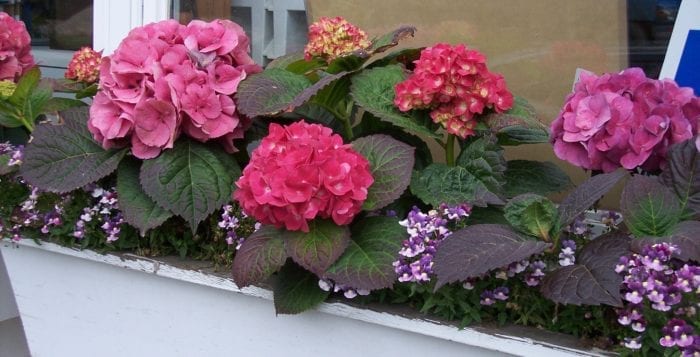By Ellen Barcel
Depending on your home and gardening style, you may want to add window boxes to at least the first floor’s front windows. I also have window boxes on windows that look out on my back patio. I like sitting in the back yard, reading my newspaper and being surrounded by these colorful plants.
In general, since window boxes are not very deep, think in terms of smaller plants, ones where the tops can be seen through the windows from inside the house, but not so tall that they totally obscure the view.
Most people use annuals since perennials will usually grow too large. I have seen window boxes filled with hydrangeas, which presented a beautiful scene all growing season long, but there are a number of problems associated with keeping perennials growing in a window box such as overwintering them. The small pots needed to fit into a window box may not provide enough protection from the cold. For another, the plants really want to get much bigger and will eventually block the view. They will easily become root bound — all roots and no soil.

Ideal window box plants are those that bloom more or less continuously throughout the growing season. I particularly like geraniums (Pelargonium) because they are drought tolerant and are, for the most part, disease and insect pest free. In other words, once planted you can pretty much ignore them except during periods of drought when they do need supplemental water. Use a good-quality potting soil and add fertilizer, following package directions. If a little is good, a lot is not necessarily better.
Other annuals that look great in a window box include marigolds and petunias. Consider adding some Dusty Miller for its contrasting light blue-gray leaves. If your window boxes don’t get a lot of sunlight, use coleus, impatiens or fuchsia.
Adding some vinelike plants creates a charming effect, as they cascade down between the flowering plants. Consider orange nasturtium scattered between white geraniums, for example, or green potato vines between hot pink geraniums in a black window box.
Herbs are great in window boxes, especially boxes that are outside kitchen windows. Usually there is enough sun and it makes harvesting the herbs for use with a meal really easy — just open your window and pick what you need. There are many herbs that are suited to window boxes such as mints, thyme and parsley. But those that get very tall, like pineapple sage, may block out your view.

Unless you have very sturdy window boxes, it may be easier for you to transfer your small seedlings into larger pots and settle those pots into the window box, rather than filling the window box itself with soil. This is especially important if your window boxes are made of wood, which may soon rot away with the damp soil. To deal with this problem, I have liners of a man-made material in several of my window boxes.
For those more exuberant gardeners, you can change the plants in the widow boxes seasonally. Maybe you want mums in the fall or small bulbs in the spring. Deadheading is one chore that annoys me but really should be done with window boxes, since the plants in them are so visible, especially those on the front of your house. So, whether you go for a very formal look, a riot of colors or a way to grow your herbs, consider widow boxes this coming gardening season.
Ellen Barcel is a freelance writer and master gardener. To reach Cornell Cooperative Extension and its Master Gardener program, call 631-727-7850.






